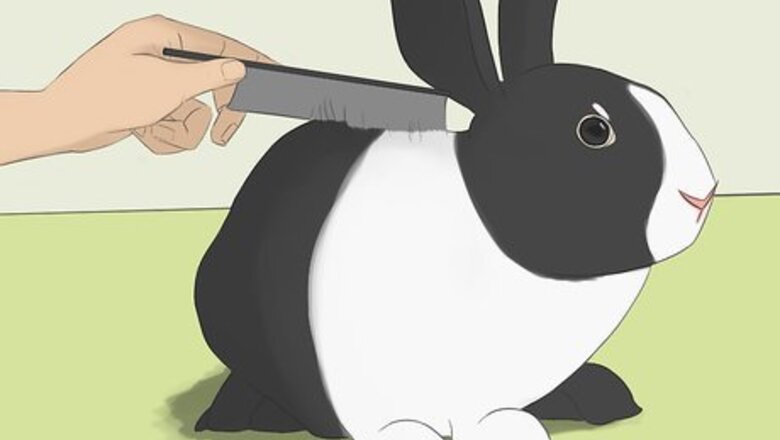
views
Grooming Your Rabbit
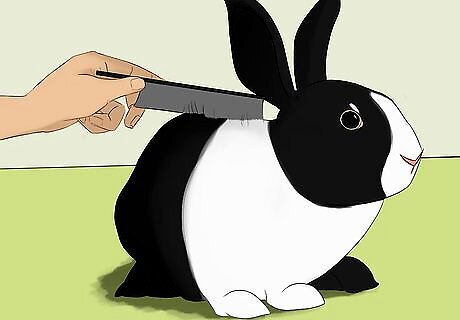
Brush the rabbit to remove bits of dirt. Many rabbits loved to be brushed, and it's a great way to help them keep their fur clean. Buy a brush made specifically for rabbit fur (often finer-toothed than brushes intended for dogs). Every few days, gently hold your rabbit while brushing its fur. Focus on areas that have bits of bedding or dirt. When you're finished, wash the brush and dry it. Be sure to handle the rabbit very gently. Not all rabbits enjoy the experience of being brushed. If yours seems startled or upset by brushing, stop the process and try again later. Long-haired rabbits require a little extra fur care. Keep your rabbit's fur trimmed to about an inch long, so that it won't become tangled. This will help cut back on shedding and keep the fur clean.
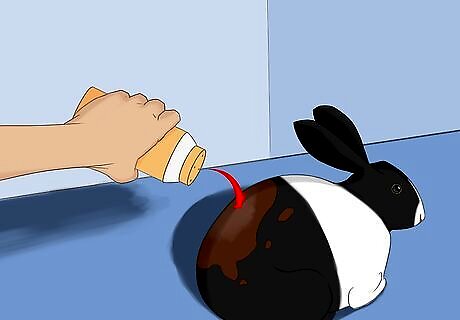
Spot clean the rabbit when necessary. If your rabbit hops into a mud puddle, you might want to help it get clean by doing a little spot cleaning. Luckily you can spot clean your rabbit without using water. This is highly advisable, since many rabbits go into shock when they get wet. Sprinkle some cornstarch over the dirty spot and use a fur comb to work out the dirt. Keep going until the fur is clean. Even if your rabbit is completely covered in mud, it's better to use this dry cleaning method than to dip your rabbit in water. Working section by section, carefully break up the mud clumps, comb out the fur, and use cornstarch to work out the smaller bits of dirt. If absolutely necessary, use water to clean small areas of fur. Dampen a washcloth with warm water and use it to moisten the fur; try not to let the water reach the rabbit's skin. When the patch of fur is clean, use a hair dryer on the coolest setting to gently blow the fur dry. Normal rabbit body temperature ranges from 101F – 103F. Because rabbit skin is very delicate, and rabbits are sensitive to heat, never use a blow dryer on a setting higher than “warm,” and constantly monitor the temperature of the air on the bunny’s skin by placing your hand in its path.
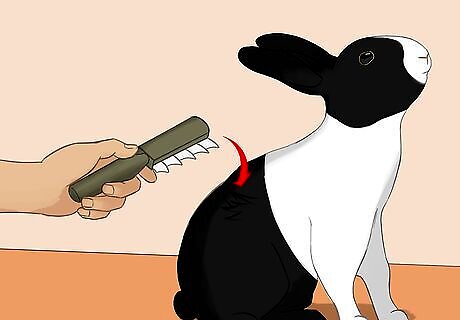
Use a mat splitter for clumped fur. If your rabbit has mats in its fur, the best tool for the job is a mat splitter. This breaks up the mat gently without harming the rabbit. Avoid using a scissors; rabbits are jumpy, and it would be easily to accidentally cut your rabbit while you work.

Trim your rabbit's nails. This grooming task is necessary for rabbits that spend most of their time indoors. When rabbits don't have the chance to wear down their nails by digging around outside, the nails can grow long and sharp. Use a rabbit nail trimmer to take care of your rabbit's nails, or ask your veterinarian to do it for you at your next appointment. Do not have your rabbit declawed. Rabbits are highly prone to infection, and declawing leaves their paws open to bacteria. Make sure the rabbit's living space is always kept clean and dry to promote good foot health.
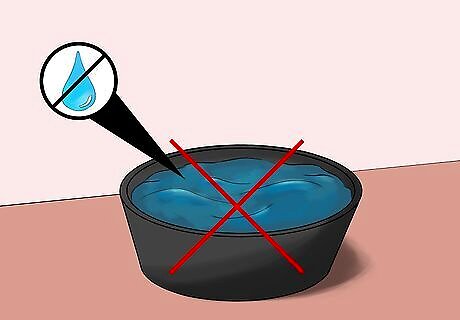
Do not submerge the rabbit in water. It bears repeating that dousing a rabbit with water can cause it to get hypothermia or go into shock, both of which can be fatal. Some unique rabbits don't mind getting wet; a few rabbit owners have even been surprised that their beloved bunnies like to swim. However, if your rabbit has not exhibited an affinity for water, it's best not to risk getting it wet. Rabbits are very sensitive and even one water bath can cause permanent damage.
Cleaning the Scent Glands
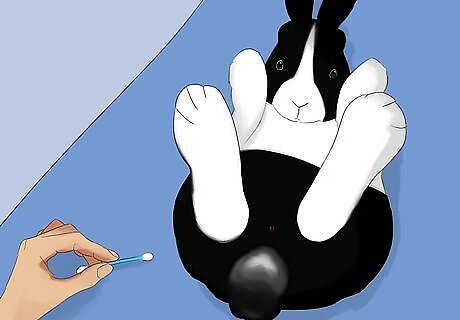
Cleanse around the anus with a cotton ball dipped in water. Rabbits have scent glands around their anus, and the excretion can build up and begin to smell after awhile. To clean this area, simply dip a cotton ball or cotton swab into warm water. Swab the area to remove all traces of excretion. If you repeat this often enough, no further cleansing should be necessary. Your rabbit may grow nervous and jumpy while you clean this area. Have a partner help you by holding and stroking the rabbit while you cleanse the scent gland area. Rabbits also have scent glands under their chins, but these do not produce a bad smell and do not need to be cleaned.
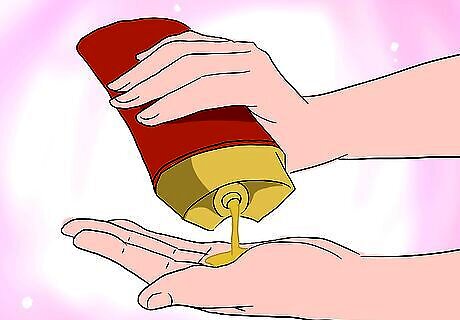
Purchase a rabbit-safe shampoo at a pet store. These are safe for rabbits and is much safer than using regular soap.
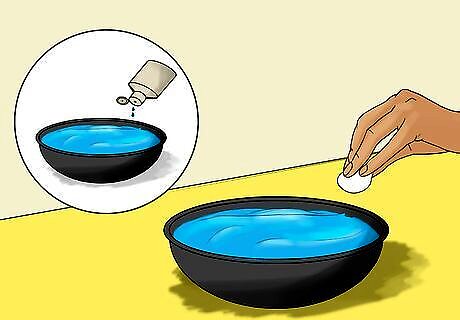
Use soap only if absolutely necessary. If the excretion has been left to build up for a long time, you may need more than water to clean it. Fill a small bowl with warm water and add a few drops of gentle baby shampoo or castile soap. Dip a cotton ball in the solution and gently cleanse around the rabbit's anus, taking care to wet only the area that needs to be cleaned. Repeat until the area no longer has traces of excretion. Make sure you don't leave any traces of soap on the rabbit. This can cause skin irritation. Do not use cold water; make sure it is sufficiently warm. Otherwise the rabbit may get cold and go into shock.

Blow dry the fur on the lowest setting. It's not a good idea to let the rabbit's body air dry, since the longer the rabbit is wet, the higher the risk of a problem developing. Use a hair dryer on a warm, low setting (not the cool or hot setting) and make a few passes over the wet part of the rabbit's behind. Continue until the fur there is completely dry. Realize that your rabbit may get scared very easily of the sound of a blow dryer. If this is the case, make sure you have a super absorbent towel on hand that is soft. Rub your rabbit until s/he is dry.
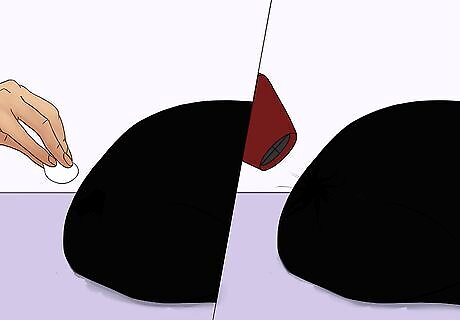
Use this method for cleansing dried urine (urine scald) as well. Some rabbits experience incontinence, the inability to hold their urine properly. Older rabbits or rabbits with an underlying medical problem commonly experience this issue. Dried urine can build up on the fur, causing a bad smell and leaving the rabbit uncomfortable. If this happens to your rabbit, Clean the area using a cotton ball dipped into water. Dry the area thoroughly with a hair dryer on a warm, low setting. Again, your rabbit may get frightened. Use a super soft towel or blanket instead if necessary. Take your rabbit to the vet to seek treatment for the underlying problem causing incontinence.
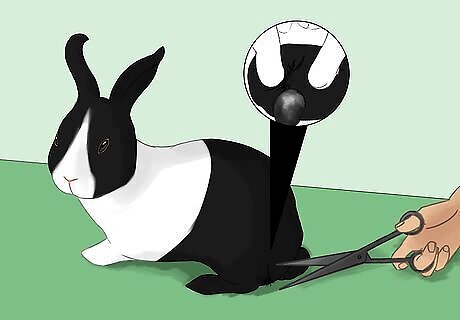
Keep fur trimmed short so the rabbit won't get damp. Long hair around the anus and underside of the rabbit can trap moisture close to the rabbit's body. Keeping the fur in these areas shaved or trimmed short helps the skin underneath dry faster and keeps the area clean. Ask your vet how to best maintain the fur on your particular breed of rabbit.
Dealing With Fleas
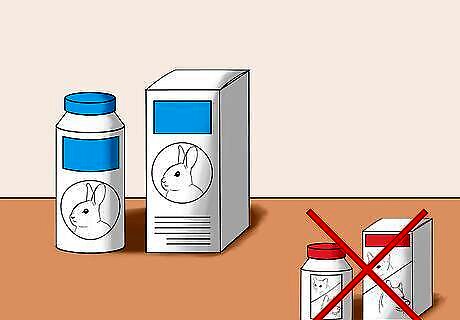
Choose a flea solution formulated for rabbits. If you notice that your rabbit has fleas, talk to your vet about using a flea solution made for rabbits. Advantage, Program and Revolution are all designed specifically to get rid of fleas on rabbits without damaging their delicate skin or otherwise impacting their system. Do not use a solution made for cats or dogs, even if it says it is also safe for use on rabbits. It's better to use one of the formulas made just for rabbits. Never submerge your rabbit in a flea dip of any kind, even if the packaging suggests it's safe to do so.
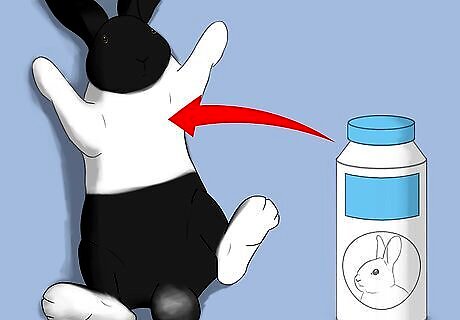
Apply the suggested dosage between the rabbit's shoulder blades. Follow the instructions from your vet or on the packaging to apply a small amount of the liquid solution to the area between your rabbit's shoulder blades. This is the safest spot to apply it since the rabbit can't reach back and scratch or lick it away. Most flea solutions require multiple applications over the course of a month. If you're not sure how much to apply, talk to your vet before taking action.
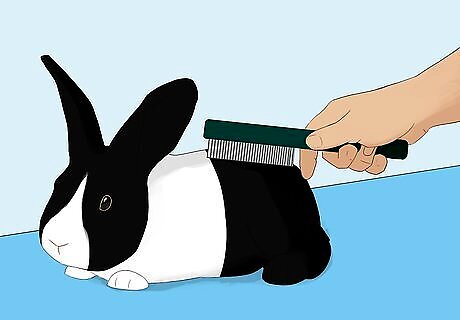
Use a flea comb to remove fleas and nits. If you prefer a natural solution, an old-fashioned flea comb does the job. In order to use this method, it's important to have a good relationship with your rabbit, since combing out fleas and nits can be quite time consuming. Have a partner hold your rabbit while you meticulously comb through its fur to pick out fleas and nits. Be sure to cover the rabbit's entire body. Check the rabbit again after a few days. In most cases you'll need to repeat the process two or three times to account for new nits hatching. After a few weeks, the fleas and their nits should be gone. In between cleanings, sanitize the flea comb by boiling it in water for five minutes.
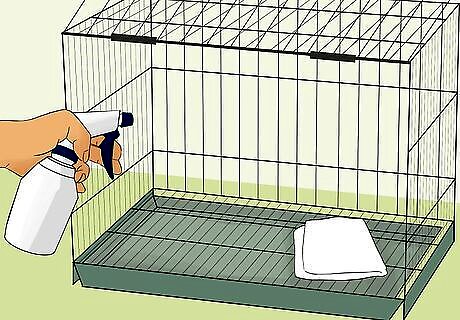
Clean the rabbit's living area thoroughly. If you found fleas on your rabbit, they have probably infested its living space (and yours) as well. Sanitize the rabbit's cage and change the bedding several times during the treatment period. Boil the rabbit's dishes and toys for five minutes to get rid of all traces of fleas, and wash blankets in very hot water. If fleas have infested your carpeting, do the following: Cover the carpet with a layer of diatomaceous earth or baking soda. Let it sit there for eight hours or overnight. This dries out the fleas' eggs. Vacuum the powder and dispose of the vacuum bag. Repeat the process every few days until all traces of fleas are gone. When your rabbit is safely in its cage, you can also catch live fleas by plugging in nightlights close to the floor. Place a bowl of soapy water under each light, and the fleas will jump in. Remove the bowls before letting your rabbit out to play.
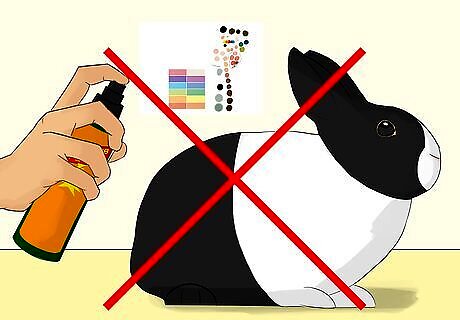
Do not use flea bombs or other external chemicals. Rabbits are quite sensitive to chemicals, and the heavy pesticides used in flea bombs are no exception. Avoid using any type of chemical solution around your rabbit. If you feel using a flea bomb or spray is the only way to get rid of the fleas, keep your rabbit in a safe location during the application process. Clean the room thoroughly with water and white vinegar to get rid of traces of the pesticides before reintroducing your rabbit to the area.




















Comments
0 comment